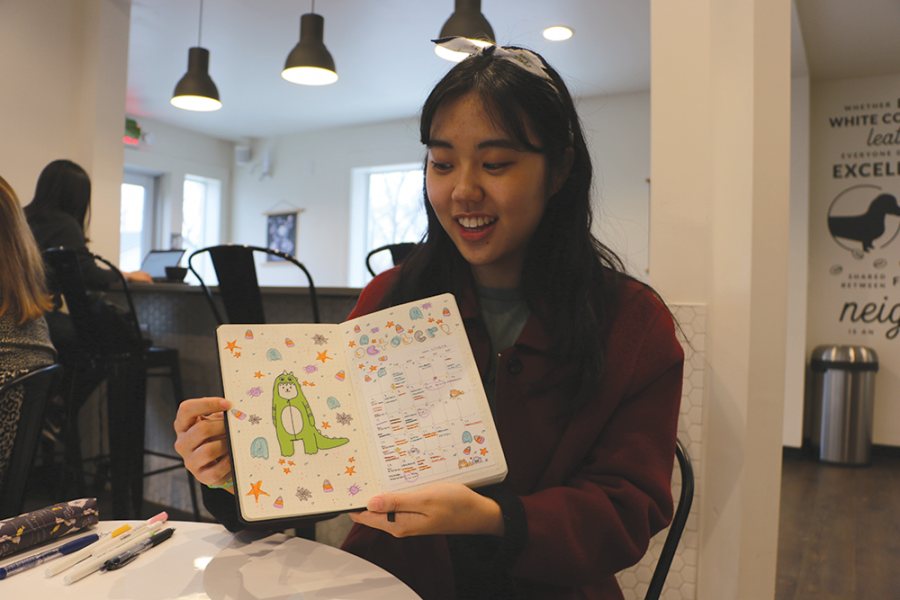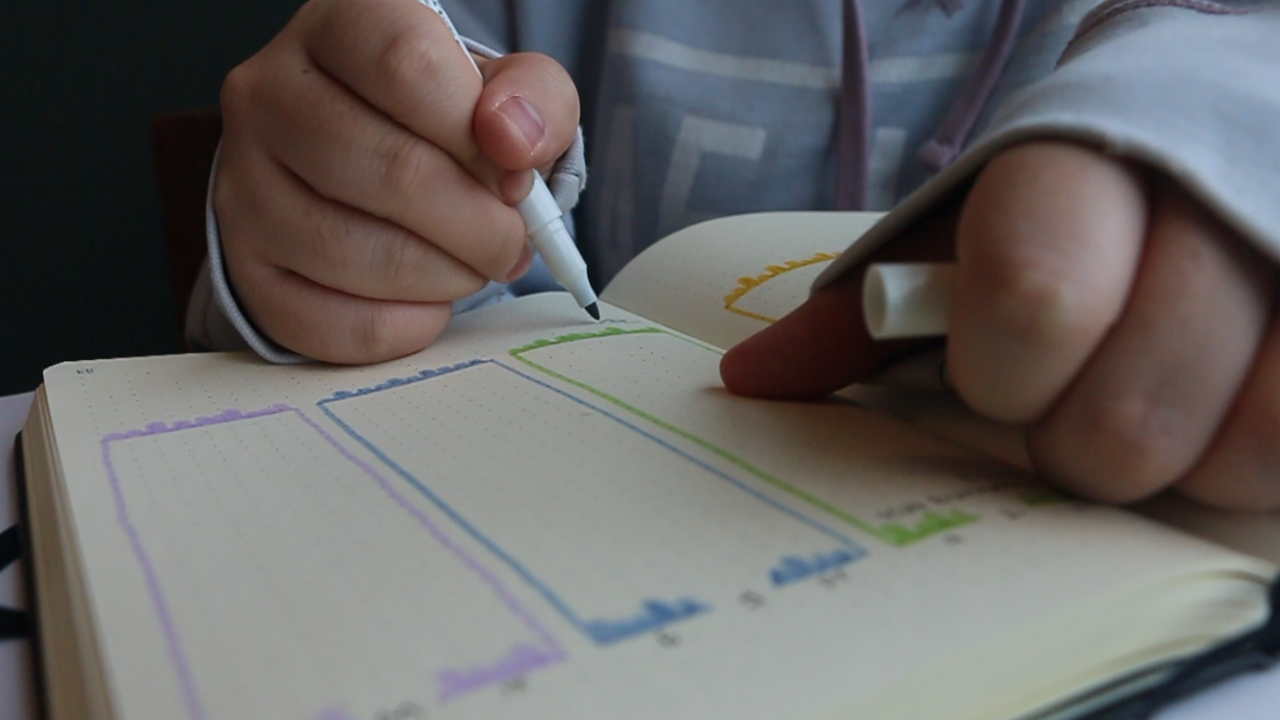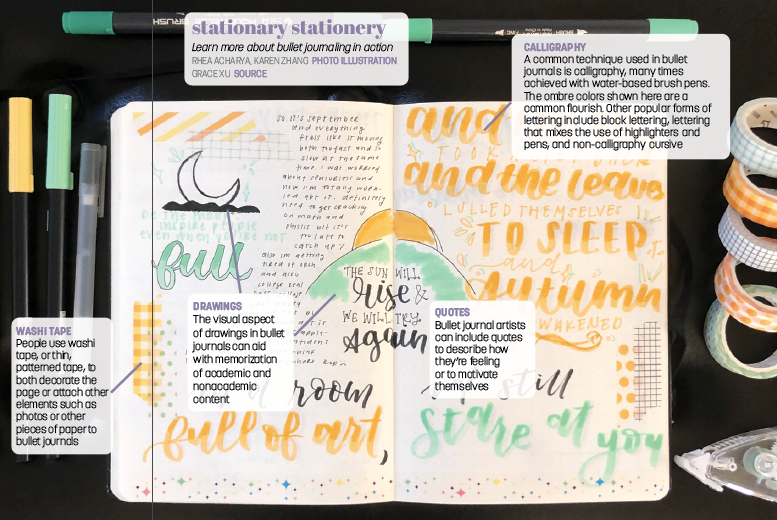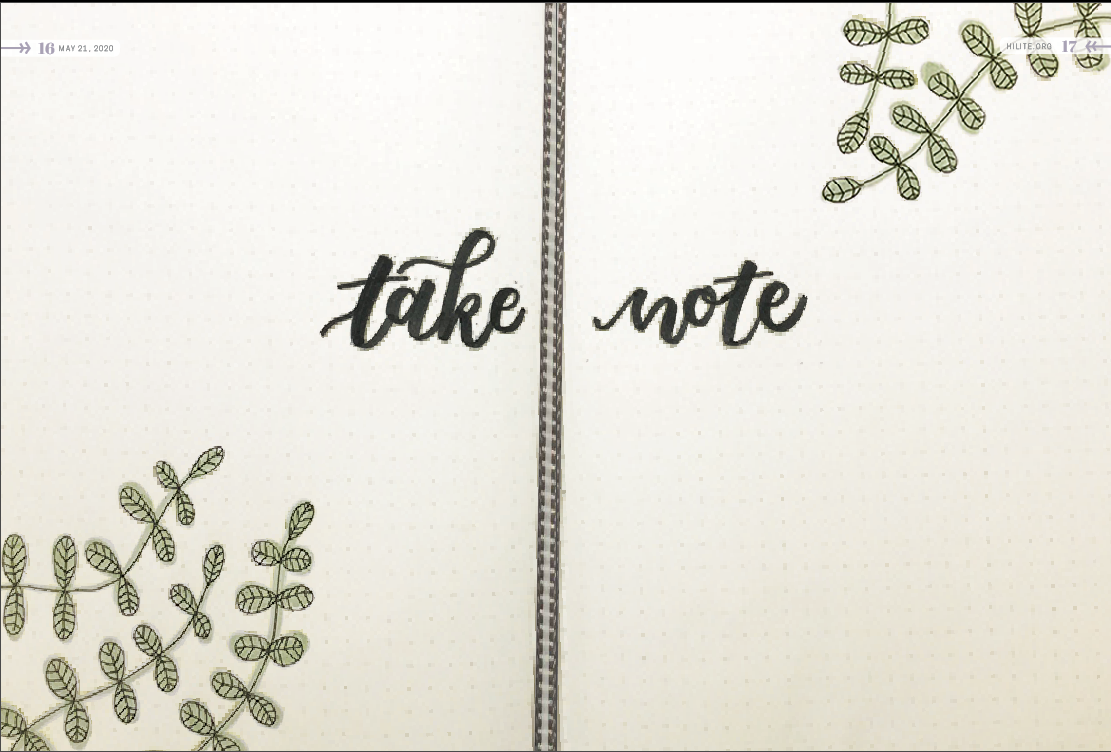Your donation will support the student journalists of Carmel High School - IN. Your contribution will allow us to purchase equipment and cover our annual website hosting costs.
With e-learning in place, CHS students, teachers see rise of aesthetics in journaling, note-taking
May 21, 2020
During quarantine, junior Emily Chan has been bullet journaling. Her process is the same each time—she makes a cover page, a monthly layout with important dates, various trackers and finally creates weekly spreads that help her keep track of her assignments and other tasks.
When she’s done, Chan will close her daisy-themed spread for May in her bullet journal before setting it aside and starting on homework.
Chan said her bullet journal represents many different things.
“For me, the concept of a bullet journal is in a way a diary, a to-do list, a journal or anything you want, combined into one book,” she said. “Instead of having multiple things everywhere, you can have it in one place.”
Chan is not the only one who bullet journals. Today, bullet journaling is one of the latest crazes in creative expression. Especially with new social distancing measures preventing some activities from occurring, many people including high schoolers now find themselves with extra time to devote to the planning or studying techniques involved with bullet journaling and aesthetic note-taking.
According to data from global information company The NPD Group, the mere act of bullet journaling is helping drive up sales of traditional supplies such as notebooks and writing instruments. Over the past year, U.S. consumers have spent nearly $210 million at retail stores for unruled spiral, composition and other notebooks—an 18% increase in sales over the prior year.

THE PERSONAL PLANNER
Perhaps one of the most important characteristics of bullet journaling, personalization, is the reason for this increasing interest.
Defining it as “the analog system for the digital age,” Ryder Carroll, the creator of the bullet journal practice, said the bullet journals are unlike conventional appointment books and planners in that they are filled with plain, unruled pages, leaving the organization and personalization completely up to the individual. Click here to see examples of spreads.
“My favorite part about the bullet journal is the creative drive and freedom of it. I can make my monthly spreads, weekly spreads or whatever I want, however I want with whatever materials I have,” Chan said.
“Not everyone has the exact same schedule that fits into a planner. An athlete might want a page that focuses on calorie intake and workouts while a (more academically-focused) student might want a page to keep track of study habits, which most planners don’t provide. With a bullet journal, they can create spreads that correlate to and benefit their life.”
Senior Jaehee Kim keeps a bullet journal and said she also likes how customizable a bullet journal can be. Click here for printables made by writing coach Grace Xu that can help you get started with your own bullet journal.
“I (keep a bullet journal), but I’m not super strict about doing it every month, every day; I do it when I have time. For me, my bullet journal is more functional; it’s there for me to keep track of what I’m doing on a weekly basis but also having it look and be customizable,” Kim said. “I have had planners in the past, and it’s not that they didn’t work well, I just like having the convenience of being able to create my own weekly and monthly spreads.”
STUDY BUDDY
Chan and Kim are just two of the many who have a bullet journal. The terms “studygram” and “studyblr” both describe social media pages of students who post photos of their bullet journal or their study notes. Currently, there are over 1 million posts tagged with #bulletjournaling and over 700,000 posts tagged with #studyspo on Instagram.
Oftentimes, these studygrams will feature photos of bullet journals as well as what are called “aesthetic notes,” which are simply a style of note-taking written in a very aesthetically-pleasing format. But while the notes are aesthetically pleasing, they have garnered criticism as some people claim these note-takers end up valuing aesthetics over the actual content and material to be learned.
However, AVID teacher Jamie Newcomer said there’s nothing wrong with taking aesthetically-pleasing notes, stating taking aesthetic notes might be the best style of note-taking for an individual.
“Especially for those who are visual learners, I think having aesthetically-pleasing notes would be good for them to help their brain process those notes because they’ve got the visual appeal and components along with just the words. I think it’s just dependent upon the student and their brains,” Newcomer said. “I know for me, I am big on color coding, so I do a lot of my notes where what’s in pink (are) words I need to go back and study and what’s in yellow are my claims and my main ideas that I need to know. So for me, because I am a visual learner, I think that’s really helpful.”
Yet despite all the benefits the aesthetics can bring to individuals, there’s an underlying tension in actions such as bullet journaling and note-taking. Many published posts and examples of bullet journals or aesthetic notes feature expensive pens, high-end laptops and perfectly swirled lattes.
For Chan, however, these pressures are not as prominent.

“Since I don’t show (my journal) to the world, I don’t feel like I have any pressure to make it look pretty. I’ll have pages that are crossed out or ripped out and I’ll be fine with that. But it’s for me; it’s not for other people to see,” Chan said. “You really don’t need to buy all those fancy pens and markers in order to make a journal. At the end of the day, you just need a book and a pen. You don’t always need to do crazy things or have a pretty aesthetic to make good habits.”
BY YOURSELF, FOR YOURSELF
Bullet journaling and this particular style of note-taking may be focused around a trendy aesthetic, but the tactile and visual aspects of it have real benefits. Recent research from National Public Radio (NPR) suggests that hand-writing notes help people process information differently than typing them, and that illustrating difficult concepts with visual representations can be far more effective for certain learners, as Newcomer said.
Kim said she agreed and said, “I think (my notes help with my academics). With some of my notes, especially for some history classes, I would draw little pictures of people or diagrams of important events that happened just so they stuck out on the paper. It made it easier for me to look back when I studied and remember what the important parts were. It’s not like I dramatically improved what grade I got, but it helped lessen the amount of time I spent studying because the notes were easier to read and I could discern what I wrote down.”
Newcomer said the way students interact with their notes is the most important part of note-taking, no matter what type of notes they are.
“It used to be that we would teach all AVID students how to take Cornell notes. But in recent years, AVID has said there are multiple ways to take notes,” Newcomer said. “You can take notes however your brain works because for some students, the Cornell note format works well. (But) for some students, it just doesn’t make sense; it doesn’t work for them. They prefer to outline their notes or they prefer to do graphic organizers as notes or they prefer to just jot down important ideas.

“I love that AVID kind of realized every student’s individuality. It’s not, ‘Here’s one way to take notes.’ It’s now saying the important piece is how you feel most comfortable taking notes. Then it’s saying, ‘Let me show you how to make these a useful study tool by interacting with them and actually using notes to study.’ That’s what I enjoy with my students. In fact, I’ll say, ‘Okay, I want to see the types of notes that you took for math.’ Some will have packets and some will have worksheets and some will have notes that they copied down from the board. We just look at those and say, ‘Okay, how did you interact with those? What was important? What questions did you have about that? How have you used those to study?’”
For bullet journaling and aesthetic note-taking, Kim said her interaction with both has helped her organization in her everyday life.
“It’s a lot easier to keep track of what I have to do if I have everything in front of me,” Kim said. “In terms of daily life, (journaling) gives me a nice brain break when I have to take a step back from studying or doing something intense.”
Chan said she agreed with Kim.
“I was really disorganized freshman year. With bullet journaling, you can keep track of either long-term due dates or goals,” Chan said. “With that, whenever I flip to a page I remember, ‘Oh, I have this thing due this day or that day.’ Seeing it written down, it’s like, ‘Oh yeah, you have to do this.’ It motivates me to do it and get it done so I can check it off or cross it off in my journal.”

However, Chan said bullet journaling has not only helped her with improving her organizational skills but also has helped her with promoting good habits, both personally and academically.
“I actually have a sleep tracker, a mood tracker and a study tracker. With those trackers, I can tell if I’m sleeping enough or if I’m having mood swings. With my habit trackers, I want to keep up my good habits. Therefore, having it marked up every single day or not makes me motivated to continue those good habits,” Chan said. “When you actually manually write it down, (bullet journaling) can definitely promote good results and habits. If you look at it every day, you get reminded of the tasks or habits you need to do.”
Ultimately, Newcomer said every student has a different learning style, so it’s up to them to find what note-taking style works for them. But both bullet journaling and aesthetic notes do offer an element of personalization.
“It’s imperative that students know how to take notes and study because that is a skill that they don’t teach you in college and they just expect you to go into the class having that,” Newcomer said. “No matter what works best, like typing them, making them pretty and highlighting and circling, printing the printout of the slide show, whatever it is for that student, I would hope that that student can leave high school saying, ‘I know what works best for me.’”

Chan said in the end, the aesthetics of note-taking and bullet journaling have given her the freedom to create whatever she wants, however she wants.
“There are no rules to a bullet journal,” Chan said. “Since the pages are blank to begin with, I can let my creativity flow and make something that’s both pleasing to the eye and that works for me.”
